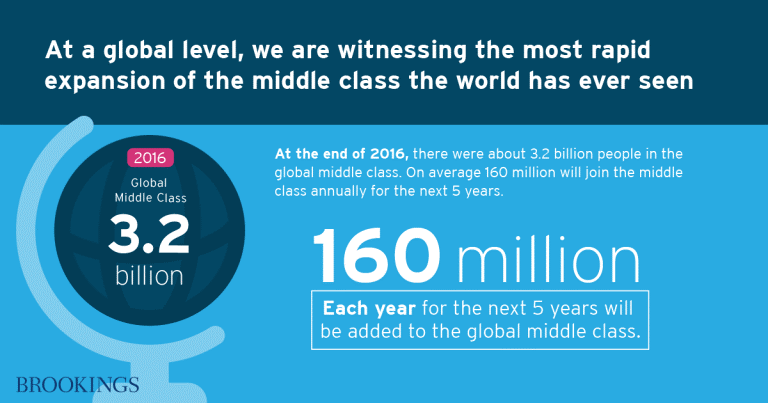We’ve been delighted to read more commentaries in U.S. news media recently about fabulous progress in reducing extreme poverty. Every day, according to the World Bank, roughly a quarter-million people are escaping extreme poverty, reducing the number of people living on less than $1.90 a day to 770 million in 2013 from 1.85 billion in 1990.
We don’t often get a view midway up the ladder of global living standards, but that is just what a new Brookings study provides.
Its title says it all: “The unprecedented expansion of the global middle class.”
What author Homi Kharas reveals about long-term trends in living standards and, in turn, prospects for the global economy in some ways are more stirring than the continuing gains in reducing extreme poverty.
Thanks to sharper analytical tools, there may be 500 million more people in the global middle class than previously thought, a total of 3.2 billion, he writes. With 160 million people likely to join in each of the next five years, the global middle class is on pace to include four billion people in 2022.
“Within a few years, based on current forecasts, a majority of the world’s population could have middle-class or rich lifestyles for the first time ever,” writes Homi, senior fellow and deputy director of Brooking’s Global Economy and Development program. “The next decade could see a faster expansion of the middle class than at any other time in history.”
(Homi interviewed me at Brookings the week An Accident of Geography was published last October.)
Once again, the big story is in Asia. Homi forecasts that nearly nine of every ten people of the next billion to enter the middle class – 88 percent – will be in Asia, led of course by China and India.
Demand for consumer durables such as washing machines, dishwashers and refrigerators are staples of middle-class life. So are recreational travel, entertainment, health care, education and transportation.
Markets for these products and services will grow as the middle-class expands in China and India. Add Indonesia, Malaysia, and southeast Asia and it’s likely that rapid economic growth in the region will continue. More so than in the U.S. and western Europe, where income inequality is higher than any time in the past 30 years.
Other key points in the report:
- Globally, the middle class is spending $35 trillion annually. By 2030, it could add $29 trillion, accounting for roughly a third of projected growth in the world’s economic output.
- Continued middle-class growth raises concerns about rising carbon emissions. Government policies will determine their scale and scope.
- Crafting political support for an expanding middle class will be a big challenge. If pursued, more trade barriers between emerging and advanced economies could thwart the growth of a global middle class, and the global economy.
A final thought: Hans Rosling, who died last month, was a Swedish epidemiologist and statistician dedicated to understanding and combating global poverty and disease. “The seemingly impossible is possible,” Rosling liked to say. “We can have a good world.”
His widely hailed TED Talks feature mesmerizing graphics, with country-specific data showing remarkable gains and positive future trends in living standards across the decades and around the globe.
If you have never seen a Rosling TED Talk, you don’t know what you are missing.


Leave a Reply